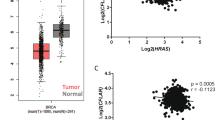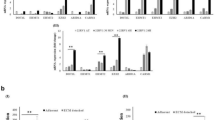Abstract
Detachment of normal epithelial cells from the extracellular matrix triggers apoptosis, a phenomenon called anoikis. Conversely, carcinoma cells tend to be relatively more anoikis-resistant than their normal counterparts, and this increased resistance represents a critical feature of the malignant phenotype. Mechanisms that control susceptibility and resistance to anoikis are not fully understood. It is now known that detachment of non-malignant epithelial cells triggers both pro- and antiapoptotic signals, and it is the balance between these signals and the duration of detachment that determine further fate of the cells. Detachment-induced antiapoptotic events delay anoikis and if cells reattach relatively soon after detachment they survive. Direct regulators of apoptosis responsible for this delay of anoikis are unknown. We found that detachment of non-malignant intestinal epithelial cells triggers upregulation of inhibitors of apoptosis protein (IAP) family, such as X-chromosome-linked inhibitor of apoptosis protein and cellular inhibitor of apoptosis-2 (cIAP2). We demonstrated that this upregulation requires detachment-dependent activation of the transcription factor nuclear factor-κB. We further observed that various IAP antagonists accelerate anoikis, indicating that upregulation of the IAPs delays detachment-triggered apoptosis. We conclude that the IAPs are important regulators of the balance between detachment-triggered life and death signals. Perhaps, not by coincidence, these proteins are often upregulated in carcinomas, tumors composed of cells that tend to be anoikis-resistant.
This is a preview of subscription content, access via your institution
Access options
Subscribe to this journal
Receive 50 print issues and online access
$259.00 per year
only $5.18 per issue
Buy this article
- Purchase on Springer Link
- Instant access to full article PDF
Prices may be subject to local taxes which are calculated during checkout






Similar content being viewed by others

References
Adams JM, Cory S . (1998). Science 281: 1322–1326.
Arnt CR, Chiorean MV, Heldebrant MP, Gores GJ, Kaufmann SH . (2002). J Biol Chem 277: 44236–44243.
Ashkenazi A . (2002). Nat Rev Cancer 2: 420–430.
Berezovskaya O, Schimmer AD, Glinskii AB, Pinilla C, Hoffman RM, Reed JC et al. (2005). Cancer Res 65: 2378–2386.
Biswas DK, Martin KJ, McAlister C, Cruz AP, Graner E, Dai SC et al. (2003). Cancer Res 63: 290–295.
Bos JL, Fearon ER, Hamilton SR, Verlaan-de Vries M, Vogelstein B . (1987). Nature 327: 293–297.
Deveraux QL, Reed JC . (1999). Genes Dev 13: 239–252.
Du C, Fang M, Li Y, Li L, Wang X . (2000). Cell 102: 33–42.
Duxbury MS, Ito H, Zinner MJ, Ashley SW, Whang EE . (2004a). Oncogene 23: 465–473.
Duxbury MS, Ito H, Zinner MJ, Ashley SW, Whang EE . (2004b). Oncogene 23: 1448–1456.
Farahani R, Fong WG, Korneluk RG, MacKenzie AE . (1997). Genomics 42: 514–518.
Ferreira CG, Van der Valk P, Span SW, Ludwig I, Smit EF, Kruyt FA et al. (2001). Clin Cancer Res 7: 2468–2474.
Freedman VH, Shin SI . (1974). Cell 3: 355–359.
Frisch SM, Francis H . (1994). J Cell Biol 124: 619–626.
Gilmore AP, Metcalfe AD, Romer LH, Streuli CH . (2000). J Cell Biol 149: 431–446.
Gottfried Y, Rotem A, Lotan R, Steller H, Larisch S . (2004). EMBO J 23: 1627–1635.
Hofmann HS, Simm A, Hammer A, Silber RE, Bartling B . (2002). J Cancer Res Clin Oncol 128: 554–560.
Holcik M, Lefebvre CA, Hicks K, Korneluk RG . (2002). BMC Genom 3: 5.
Ikeda H, Suzuki Y, Suzuki M, Koike M, Tamura J, Tong J et al. (1998). Gut 42: 530–537.
Jiang K, Sun J, Cheng J, Djeu JY, Wei S, Sebti S . (2004). Mol Cell Biol 24: 5565–5576.
Kagawa S, Fujiwara T, Hizuta A, Yasuda T, Zhang WW, Roth JA et al. (1997). Oncogene 15: 1903–1909.
Kishida S, Yamamoto H, Ikeda S, Kishida M, Sakamoto I, Koyama S et al. (1998). J Biol Chem 273: 10823–10826.
Krajewska M, Kim H, Kim C, Kang H, Welsh K, Matsuzawa S et al. (2005). Clin Cancer Res 11: 5451–5461.
Krajewska M, Krajewski S, Banares S, Huang X, Turner B, Bubendorf B et al. (2003). Clin Cancer Res 9: 4914–4925.
LaCasse EC, Baird S, Korneluk RG, MacKenzie AE . (1998). Oncogene 17: 3247–3259.
Li P, Nijhawan D, Budihardjo I, Srinivasula SM, Ahmad M, Alnemri ES et al. (1997). Cell 91: 479–489.
Lin MT, Chang CC, Chen ST, Chang HL, Su JL, Chau YP et al. (2004). J Biol Chem 279: 24015–24023.
Liu Z, Li H, Derouet M, Berezkin A, Sasazuki T, Shirasawa S et al. (2006). J Biol Chem 281: 14738–14747.
Liu Z, Li H, Derouet M, Filmus J, LaCasse EC, Korneluk RG et al. (2005). J Biol Chem 280: 37383–37392.
Locksley RM, Killeen N, Lenardo MJ . (2001). Cell 104: 487–501.
Loza-Coll MA, Perera S, Shi W, Filmus J . (2005). Oncogene 24: 1727–1737.
Lu Y, Lin YZ, LaPushin R, Cuevas B, Fang X, Yu SX et al. (1999). Oncogene 18: 7034–7045.
McFall A, Ulku A, Lambert QT, Kusa A, Rogers-Graham K, Der CJ . (2001). Mol Cell Biol 21: 5488–5499.
Natarajan K, Singh S, Burke Jr TR, Grunberger D, Aggarwal BB . (1996). Proc Natl Acad Sci USA 93: 9090–9095.
Olson M, Kornbluth S . (2001). Curr Mol Med 1: 91–122.
Orford K, Orford CC, Byers SW . (1999). J Cell Biol 146: 855–868.
Papadopoulos N, Nicolaides NC, Liu B, Parsons R, Lengauer C, Palombo F et al (1995). Science 268: 1915–1917.
Puthalakath H, Villunger A, O'Reilly LA, Beaumont JG, Coultas L, Cheney RE et al. (2001). Science 293: 1829–1832.
Rak J, Mitsuhashi Y, Erdos V, Huang SN, Filmus J, Kerbel RS . (1995). J Cell Biol 131: 1587–1598.
Rak J, Mitsuhashi Y, Sheehan C, Krestow JK, Florenes VA, Filmus J et al. (1999). Neoplasia 1: 23–30.
Reginato MJ, Mills KR, Paulus JK, Lynch DK, Sgroi DC, Debnath J et al. (2003). Nat Cell Biol 5: 733–740.
Rodeck U, Jost M, DuHadaway J, Kari C, Jensen PJ, Risse B et al. (1997). Proc Natl Acad Sci USA 94: 5067–5072.
Rodenhuis S, Slebos RJ, Boot AJ, Evers SG, Mooi WJ, Wagenaar SS et al. (1988). Cancer Res 48: 5738–5741.
Rosen K, Coll ML, Li A, Filmus J . (2001). J Biol Chem 276: 37273–37279.
Rosen K, Rak J, Jin J, Kerbel RS, Newman MJ, Filmus J . (1998). Curr Biol 8: 1331–1334.
Rosen K, Rak J, Leung T, Dean NM, Kerbel RS, Filmus J . (2000). J Cell Biol 149: 447–456.
Rosen K, Shi W, Calabretta B, Filmus J . (2002). J Biol Chem 277: 46123–46130.
Ruemmele FM, Beaulieu JF, O'Connell J, Bennett MW, Seidman EG, Lentze MJ . (2002). Biochem Biophys Res Commun 290: 1308–1314.
Rytomaa M, Lehmann K, Downward J . (2000). Oncogene 19: 4461–4468.
Rytomaa M, Martins LM, Downward J . (1999). Curr Biol 9: 1043–1046.
Satoh T, Endo M, Nakafuku M, Akiyama T, Yamamoto T, Kaziro Y . (1990). Proc Natl Acad Sci USA 87: 7926–7929.
Scotlandi K, Maini C, Manara MC, Benini S, Serra M, Cerisano V et al. (2002). Cancer Gene Ther 9: 296–307.
Shi Y, Brands FH, Chatterjee S, Feng AC, Groshen S, Schewe J et al. (2001). J Urol 166: 1514–1519.
Shimizu S, Kanaseki T, Mizushima N, Mizuta T, Arakawa-Kobayashi S, Thompson CB et al. (2004). Nat Cell Biol 6: 1221–1228.
Shirasawa S, Furuse M, Yokoyama N, Sasazuki T . (1993). Science 260: 85–88.
Signoretti S, Montironi R, Manola J, Altimari A, Tam C, Bubley G et al. (2000). J Natl Cancer Inst 92: 1918–1925.
Stehlik C, de Martin R, Kumabashiri I, Schmid JA, Binder BR, Lipp J . (1998). J Exp Med 188: 211–216.
Suzuki Y, Imai Y, Nakayama H, Takahashi K, Takio K, Takahashi R . (2001). Mol Cell 8: 613–621.
Toruner M, Fernandez-Zapico M, Sha JJ, Pham L, Urrutia R, Egan LJ . (2006). J Biol Chem 281: 8686–8696.
Tsujimoto Y . (2003). J Cell Physiol 195: 158–167.
Vachon PH, Harnois C, Grenier A, Dufour G, Bouchard V, Han J et al. (2002). Gastroenterology 123: 1980–1991.
van Loo G, van Gurp M, Depuydt B, Srinivasula SM, Rodriguez I, Alnemri ES et al. (2002). Cell Death Differ 9: 20–26.
Verhagen AM, Ekert PG, Pakusch M, Silke J, Connolly LM, Reid GE et al. (2000). Cell 102: 43–53.
Verhagen AM, Silke J, Ekert PG, Pakusch M, Kaufmann H, Connolly LM et al. (2002). J Biol Chem 277: 445–454.
Wang CY, Mayo MW, Korneluk RG, Goeddel DV, Baldwin Jr AS . (1998). Science 281: 1680–1683.
Wang P, Valentijn AJ, Gilmore AP, Streuli CH . (2003). J Biol Chem 278: 19917–19925.
Watabe M, Hishikawa K, Takayanagi A, Shimizu N, Nakaki T . (2004). J Biol Chem 279: 6017–6026.
Yamakita Y, Totsukawa G, Yamashiro S, Fry D, Zhang X, Hanks SK et al. (1999). J Cell Biol 144: 315–324.
Yan SR, Joseph RR, Rosen K, Reginato MJ, Jackson A, Allaire N et al. (2005). Oncogene 24: 6482–6491.
Acknowledgements
This work was supported by The Terry Fox Foundation (through The National Cancer Institute of Canada, Grant no. 015397). Hongbing Li is a recipient of a Postdoctoral Traineeship Award from the Dalhousie Cancer Research Training Program. Byong Hoon Yoo is a recipient of a Postdoctoral Research Fellowship from the IWK Health Centre. We are grateful to Dr X Wang for the Smac expression vector.
Author information
Authors and Affiliations
Corresponding author
Rights and permissions
About this article
Cite this article
Liu, Z., Li, H., Wu, X. et al. Detachment-induced upregulation of XIAP and cIAP2 delays anoikis of intestinal epithelial cells. Oncogene 25, 7680–7690 (2006). https://doi.org/10.1038/sj.onc.1209753
Received:
Revised:
Accepted:
Published:
Issue Date:
DOI: https://doi.org/10.1038/sj.onc.1209753


